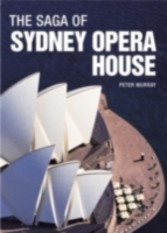
The Saga of Sydney Opera House

von: Peter Murray
Spon Press, 2003
ISBN: 9780203358160
Sprache: Englisch
145 Seiten, Download: 7151 KB
Format: PDF, auch als Online-Lesen
CHAPTER 1 A MAGNIFICENT DOODLE (p. 1-2)
In 1957, it took three days to fly from London Heathrow to Sydney and cost £430 and 4 shillings sterling. The journey included refuelling stops in Zurich, Istanbul, Karachi, Calcutta, Singapore, Jakarta and Darwin. Communication by telephone was expensive, connections had to be booked in advance and the quality of line was variable. Urgent communication was generally by telex or telegram. Today we inhabit a world of instant communications, of faxes, mobile phones, e-mails and the internet: it is hard to recall the meaning of distance in the days before the jet plane took over the skies. An appreciation of just how far away Sydney seemed from Europe in the 1950s is important in understanding the difficulties that beset the design and construction of the Opera House.
The complications of cultural differences, of communications, of professional procedures and the fact that the long-distance traveller was virtually incommunicado all played their part in the unfolding drama.
It was clearly unrealistic for many of the overseas entrants to the Opera House competition to visit the proposed site and the first time Jørn Utzon saw the New South Wales capital and Bennelong Point, the striking promontory selected for the building, was in July 1957, six months after it was announced that he had won the competition for the new building. Utzon had studied the qualities of the promontory from photographs and postcards. It is a mark of his genius that he so brilliantly interpreted the location, the light and the landscape with his sculptural forms.
On first seeing Bennelong Point, he exclaimed to a Sydney Morning Herald reporter, ‘It’s absolutely breathtaking. There’s no opera site in the world to compare with it…this site is even more beautiful than in the photographs from which I worked.’ The selection of Bennelong Point for the future Sydney Opera House had been pinpointed in the early 1940s by the National Theatre Movement of Australia, but it was the support of Eugene Goossens, conductor of the Sydney Symphony Orchestra (SSO) that ensured its selection in preference to sites in the centre of town. Goossens was a driving force behind the project. He had been invited to take over the orchestra by Charles Moses, the General Manager of the Australian Broadcasting Commission (ABC). In order to match the salary Goossens was receiving at the time from the Cincinnatti Symphony Orchestra, Moses arranged for him to act as Director of the Sydney Conservatorium, which is located in the Royal Botanic Gardens overlooking Circular Quay and Bennelong Point.
At that time, SSO concerts were given in the Sydney Town Hall. Although acoustically adequate, it was hardly a suitable venue for Australia’s top orchestra. It also lacked basic facilities, it was virtually unheatable in winter and concert-goers were forced to don hats and gloves. The Sydney Town Hall management refused to provide any sort of refreshments and the audience had to decamp to the pub across the road at the interval.
Many of the regular concert-goers were recent immigrants from Europe where they were used to much better facilities.
The SSO programme of concerts was well established, opera, however, was a minority interest. There were some local amateur groups and the occasional tour from an Italian company, but that was it. As a city, Sydney was overshadowed by Melbourne and was a far cry from the cosmopolitan metropolis it is today. It was something of a backwater where the pubs closed at 6.00pm.
Goossens arrived to take up his post in July 1947 and told the Sydney Morning Herald that he would build up the SSO into one of the six best orchestras in the world, he wanted to create a fine concert hall with perfect acoustics and seating for 3,500 people, a home for an opera company and a smaller hall for chamber music. The brief for the Sydney Opera House was born. Goossens plugged away for several years with little official response to his idea until 1954 when, through Moses’ good offices, he met the Labor Premier, Joe Cahill, to explain his plans. The response was positive. The decision to hold the 1956 Olympic Games in Melbourne had prompted Sydney to try and raise its sights and a cultural initiative of this kind was just what was needed. Cahill agreed to call a public meeting to discuss the ‘question of the establishment of an opera house in Sydney.’







